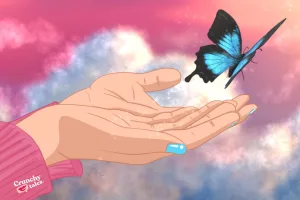Kintsugi After 50: 5 Steps To Turn Life’s Cracks into Golden Strength
Life after fifty is often portrayed as a gentle downhill slope, a time to slow down and settle into a quieter rhythm. Yet this familiar narrative misses the nuance of this stage of life. Here, wounds, cracks, and setbacks are no longer merely burdens; they are evidence of survival, markers of a life fully lived.
It’s precisely in this season that the philosophy of Kintsugi becomes profoundly relevant. More than a method for repairing broken pottery, this Japanese art offers a transformative blueprint for embracing your history, honoring your fractures, and forging resilience that doesn’t just endure, but glows with the brilliance of pure gold.
“Kintsugi is life’s way of saying, nobody’s perfect -says Candice Kumai, author of Kintsugi Wellness. The Japanese Art of Nourishing Mind, Body, and Spirit – The path is not straight. In fact, your hardest challenges, deepest wounds, and greatest fears are actually among the most beautiful, precious, and admirable parts of you.”
Through Kintsugi, life after fifty can be seen as a period of extraordinary depth, beauty, and renewed strength.
Kintsugi For The Soul: A Profound Metaphor for Midlife and Beyond
 The Kintsugi philosophy applied to life: our ‘breaks’, the challenges and setbacks we face, can be mended not to hide the damage, but to highlight it as a source of profound strength and beauty.
The Kintsugi philosophy applied to life: our ‘breaks’, the challenges and setbacks we face, can be mended not to hide the damage, but to highlight it as a source of profound strength and beauty.
Ageing isn’t about perfection. It’s about integrating every piece of ourselves with grace, and Kintsugi, far from being only a pottery technique, offers a powerful metaphor for this. It helps us understand the experiences, losses, reinventions, and recoveries that have shaped us into more textured, resilient, and deeply human versions of ourselves.
What is Kintsugi? More Than Just Fixing Broken Pottery
To fully grasp the power of Kintsugi as a lifestyle philosophy, one must first appreciate its origins as a meticulous and meaningful craft. It is an art form that elevates repair to an act of creation, embedding a deep respect for history and impermanence into every golden seam.
At its core, the 15th-Century practice of Kintsugi, which translates “to join with gold“, is the intricate process of repairing broken pottery. It is a testament to the idea that breakage and repair are part of an object’s life, not an end to it. Craftsmen use a natural lacquer derived from the Urushi tree to painstakingly glue the shattered pieces of ceramics back together. Before the lacquer fully cures, it is dusted with precious metals, most commonly gold, but also silver or platinum.
This technique doesn’t just fix the object; it highlights the lines of fracture, celebrating them as a map of its journey. The repaired piece becomes a unique work of art, valued more highly for its history of being broken than if it had remained pristine.
As a metaphor for life after 50, Kintsugi is unparalleled. It teaches us to see our life’s “breaks”, not as failures to be hidden, but as opportunities for a profound transformation into something more resilient, more beautiful, and undeniably stronger. A reminder to stay optimistic when things fall apart and to celebrate the flaws and missteps of life.
What is the philosophy behind kintsugi? Finding Beauty in Imperfection (Wabi-Sabi)
Kintsugi is the physical embodiment of the Japanese philosophy of wabi-sabi. This worldview finds beauty in things that are imperfect, impermanent, and incomplete.
Wabi relates to a sense of rustic simplicity and quietness, while sabi refers to the beauty or serenity that comes with age, when an object’s life and its impermanence are evident in its patina and wear. Together, they foster an appreciation for authenticity and the natural cycle of growth and decay.
Kintsugi applies this philosophy directly to damage and repair. It rejects the modern impulse to discard and replace, instead championing a mindful process of healing that acknowledges scars not as blemishes, but as a testament to survival and resilience. Psychologist Tomás Navarro, in his book Kintsugi: Embrace Your Imperfections and Find Happiness – The Japanese Way, writes that ceramics and life can break apart, but this should not prevent us from living intensely. The first step to living a Kintsugi life is to not fear taking risks or getting damaged. Seeking a life without suffering only leads to surviving rather than truly living.
Ceramics are fragile, strong and beautiful all at once, just like people- he says -. Ceramics and life can break apart, but not for that reason should we stop living intensely. The first step to living a Kintsugi life is to not be scared of taking risks and getting damaged. Do not try to live a pleasant life without suffering, because if you do you will be resigning yourself to surviving instead of living intensely.
Recognizing The Life’s Cracks After 50
The “cracks” we accumulate during our life-journey are not abstract concepts; they are tangible experiences that have shaped our character, worldview, and inner strength. Recognizing them is the first step toward mending them with gold.
These cracks can include:
- Career Shifts and Redundancy: The sudden end of a long-held career or the feeling of being professionally invisible.
- Health Challenges: Confronting one’s own mortality through illness or the natural changes of an aging body.
- Shifting Family Dynamics: The “empty nest,” caring for aging parents, or navigating new roles as grandparents.
- Grief and Loss: The accumulated sorrow from losing parents, friends, or partners.
- Relationship Fractures: Divorce, estrangement, or the slow drifting apart from once-close friends.
- Existential Questions: A deep-seated questioning of purpose, legacy, and the meaning of the years that remain.
These experiences represent significant points of breakage. They can leave us feeling fragmented, diminished, or uncertain. The Kintsugi philosophy invites us not to ignore these cracks but to see them clearly, acknowledging the pain and disruption they represent.
From Scars to Stories: Reframing Your Past
Our scars, both visible and invisible, are often sources of shame. We try to cover them, forget them, and present a facade of unbrokenness. Kintsugi offers a radical alternative: reframing these scars as stories. The good news? The crucial insight of Kintsugi is that the material for repair is already within you and after 50, our reserves of “gold” are deeper than ever.
We possess a hard-won perspective that allows us to see the bigger picture. This hidden resilience is the lacquer and gold that will bind our fragments together, not just restoring us but making you fundamentally stronger. Each golden line on a repaired bowl tells the tale of its fall and its restoration. Similarly, your scars are not marks of weakness; they are testaments to your survival. They are the narrative threads that make your life story compelling and authentic.
For example, the scar from a painful divorce speaks of your capacity to love and your strength to heal. The ache of a career disappointment tells a story of ambition and adaptation. By viewing your past through this lens, you transform sources of pain into badges of honor, each one a chapter in the epic of your unyielding life.
The Power of Transformation: Turning Cracks into Golden Strength
Acknowledging life’s cracks is only the beginning. The true magic of the Kintsugi philosophy lies in the active process of transformation: the spiritual alchemy of turning pain into power, experience into wisdom, and fragility into an unyielding fortitude. This is where you consciously choose to mend with gold.
The Kintsugi process encourages a mindful excavation of this past. Instead of letting old wounds fester, you can revisit them with curiosity and compassion, asking: What did this teach me? How did I grow from this? What strength did I discover?
This act of reflection is the process of smelting raw pain into the pure gold of wisdom and that is good also because the pain that is not transformed is transmitted. It can manifest as bitterness, fear, or a shrinking of one’s world. Kintsugi offers a path to transformation, turning the static energy of past trauma into dynamic, forward-moving purpose.
When you mend a crack with the gold of self-awareness and healing, you are fundamentally changing its nature.
A memory that once caused a sharp intake of breath can become a source of empathy for others. A failure that once brought shame can become the foundation for a new venture, built on the lessons learned. This transformation is not about forgetting the pain; it is about integrating it so thoroughly that it becomes fuel for a more meaningful existence.
Your repaired self can now serve a higher purpose, guiding others with the light that shines from your own golden seams.
Your Kintsugi Practice: Actionable Steps for a Golden Life After 50
The philosophy of Kintsugi is beautiful, but its true power is unlocked when it becomes an active practice. Applying its principles to your life requires intention, mindfulness, and courage.
Here is a five-step guide to begin your own Kintsugi journey, turning the cracks of your experience into sources of golden, unyielding strength.

Step 1: Acknowledge and Assess Your Life’s Cracks with Clarity
You cannot mend what you do not see. The first step is to engage in a process of honest self-assessment, much like an artisan examining the shattered pieces of a bowl. This requires dedicated time for quiet reflection, free from distraction. Use mindfulness practices or journaling to gently explore your past and present. Ask yourself:
- Where are the fracture lines in my life story?
- What past hurts, disappointments, or traumas have I tried to hide or ignore?
- What current transitions or challenges feel like points of breakage?
The goal is not to dwell in pain but to acknowledge it with compassionate clarity. Lay all the pieces out without judgment. This act of naming and accepting your cracks is the essential groundwork for any meaningful repair.
Step 2: Choose Your “Gold” – Identifying Resources and Values
The “gold” used in your personal Kintsugi is the unique combination of your inner resources and core values. This is the precious material you will use to bind the fragments. Take inventory of your personal gold. This might include:
- Strengths & Resilience: Identify times you have overcome adversity. What qualities did you draw upon? Courage, humor, perseverance, creativity?
- Core Values: What principles guide your life? Honesty, compassion, loyalty, freedom? Aligning your healing with your values makes the repair authentic and strong.
- Support Systems: Who are the people that form your safety net? Friends, family, mentors, or therapists who offer love and perspective.
- Wisdom & Experience: What hard-won lessons has life taught you? This deep knowledge is a potent form of gold.
By identifying these resources, you gather the materials needed for the delicate art of repair, recognizing that you already possess everything you need.
Step 3: The Art of Gentle Repair – Self-Compassion and Conscious Healing
This is the heart of the practice, where the lacquer of self-compassion is applied. Mending is not a rushed or violent act; it is slow, deliberate, and gentle. Conscious healing involves actively applying your “gold” to your “cracks.” This can take many forms:
- Reframing Narratives: Consciously rewrite the stories you tell yourself about your past failures or traumas, focusing on the strength and learning you gained.
- Seeking Professional Help: Therapy or counseling can be a powerful tool, providing the expert guidance to piece together particularly fragmented parts of your psyche.
- Practicing Forgiveness: This includes forgiving others who have hurt you and, most importantly, forgiving yourself for past mistakes. Forgiveness is the lacquer that allows the pieces to join.
- Mindfulness and Self-Care: Engage in practices that soothe your nervous system and foster a kind relationship with your mind and body.
This step is a commitment to treating yourself with the same care and respect a Kintsugi master gives to a priceless piece of ceramics.
Step 4: Displaying Your Golden Scars – Integration and Sharing
A Kintsugi piece is not hidden away after its repair; it is displayed with pride. Similarly, this step is about integrating your healed self back into the world. It means ceasing to hide your imperfections and instead allowing your story to be seen. This doesn’t require broadcasting your trauma, but it does mean living more authentically. It could look like:
- Sharing Your Wisdom: Offering guidance to someone younger who is going through a challenge you have already navigated.
- Embracing Vulnerability: Allowing trusted loved ones to see your whole self, including the mended parts.
- Living Your Story: Making life choices that reflect your journey and the person you have become, not the person you think you should be.
Your golden scars become a source of connection and inspiration, a quiet testament to the beauty of resilience.
Step 5: Living a Golden, Unyielding Life – Continual Growth and Purpose
Kintsugi is not a one-time fix. Life will inevitably present new challenges and potential cracks. This final step is about adopting Kintsugi as an ongoing lifestyle philosophy. It is a commitment to seeing every future challenge as an opportunity to apply the art of golden repair. This means:
- Embracing Impermanence: Accepting that change and even breakage are natural parts of life, reducing the fear of future adversity.
- Finding Purpose in Your Story: Using your unique, mended perspective to contribute to your community, family, or work in a meaningful way.
- Continuing Self-Reflection: Regularly checking in with yourself, tending to small cracks before they become major breaks.
Ultimately, the Kintsugi philosophy offers more than just a comforting metaphor; it provides a powerful, actionable framework for a life of continued growth and strength.
Let’s follow Thomas Navarro‘s guiding words: “We humans are fragile; susceptible to breaks and knocks. Discover how to pick up the pieces and repair what may have been damaged in your life. Find out how to embrace your emotional scars and make them beautiful”.
Like this post? Support Us or Sign up to our newsletter to get more articles like this delivered straight to your inbox!





